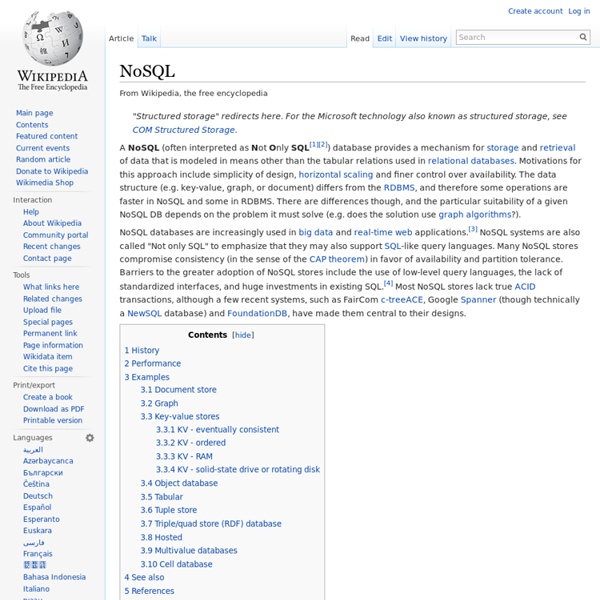Home · tinkerpop/blueprints Wiki
Blueprints is a collection of interfaces, implementations, ouplementations, and test suites for the property graph data model. Blueprints is analogous to the JDBC, but for graph databases. As such, it provides a common set of interfaces to allow developers to plug-and-play their graph database backend.
Kyoto Cabinet: a straightforward implementation of DBM
Copyright (C) 2009-2012 FAL Labs Last Update: Fri, 04 Mar 2011 23:07:26 -0800 Overview Kyoto Cabinet is a library of routines for managing a database. The database is a simple data file containing records, each is a pair of a key and a value.
MongoDB
MongoDB (from "humongous") is a cross-platform document-oriented database. Classified as a NoSQL database, MongoDB eschews the traditional table-based relational database structure in favor of JSON-like documents with dynamic schemas (MongoDB calls the format BSON), making the integration of data in certain types of applications easier and faster. Released under a combination of the GNU Affero General Public License and the Apache License, MongoDB is free and open-source software.
Oracle Database 12c Release 1 (12.1) New Features
The following sections describe the new business intelligence and data warehousing features for Oracle Database 12c Release 1 (12.1). 1.2.1 Oracle Advanced Analytics The following sections describe new Oracle Advanced Analytics features. 1.2.1.1 Decision Tree Mining Text Data The Decision Tree algorithm now supports nested data and can be used for text mining. Decision Tree is popular due to its transparency and prevalence, therefore, it is important to enable the algorithm to handle unstructured data.
NewSQL
NewSQL is a class of modern relational database management systems that seek to provide the same scalable performance of NoSQL systems for online transaction processing (OLTP) read-write workloads while still maintaining the ACID guarantees of a traditional database system.[1][2][3] History[edit] The term was first used by 451 Group analyst Matthew Aslett in a 2011 research paper discussing the rise of new database systems as challengers to established vendors.[1] Many enterprise systems that handle high-profile data (e.g., financial and order processing systems) also need to be able to scale but are unable to use NoSQL solutions because they cannot give up strong transactional and consistency requirements. [1][4] The only options previously available for these organizations were to either purchase a more powerful single-node machine or develop custom middleware that distributes queries over traditional DBMS nodes. Systems[edit] New architectures[edit]
Home · tinkerpop/pipes Wiki
Pipes is a dataflow framework using process graphs. A process graph is composed of Pipe vertices connected by communication edges. A Pipe implements a simple computational step that can be composed with other Pipe objects to create a larger computation. Such data flow graphs allow for the splitting, merging, looping, and in general, the transformation of data from input to output. There are numerous Pipe classes that come with the main Pipes distribution.
NoSQL Data Modeling Techniques « Highly Scalable Blog
NoSQL databases are often compared by various non-functional criteria, such as scalability, performance, and consistency. This aspect of NoSQL is well-studied both in practice and theory because specific non-functional properties are often the main justification for NoSQL usage and fundamental results on distributed systems like the CAP theorem apply well to NoSQL systems. At the same time, NoSQL data modeling is not so well studied and lacks the systematic theory found in relational databases. In this article I provide a short comparison of NoSQL system families from the data modeling point of view and digest several common modeling techniques.
CouchDB
Apache CouchDB, commonly referred to as CouchDB, is an open source database that focuses on ease of use and on being "a database that completely embraces the web".[1] It is a NoSQL database that uses JSON to store data, JavaScript as its query language using MapReduce, and HTTP for an API.[1] One of its distinguishing features is multi-master replication. CouchDB was first released in 2005 and later became an Apache project in 2008. Unlike in a relational database, CouchDB does not store data and relationships in tables. Instead, each database is a collection of independent documents.
Home · tinkerpop/rexster Wiki
Rexster is a graph server that exposes any Blueprints graph through REST and a binary protocol called RexPro. The HTTP web service provides standard low-level GET, POST, PUT, and DELETE methods, a flexible extensions model which allows plug-in like development for external services (such as adhoc graph queries through Gremlin), server-side “stored procedures” written in Gremlin, and a browser-based interface called The Dog House. Rexster Console makes it possible to do remote script evaluation against configured graphs inside of a Rexster Server.1 Rexster Kibbles is a collection of various Rexster server extensions provided by TinkerPop. Please join the Gremlin users group at for all TinkerPop related discussions.



